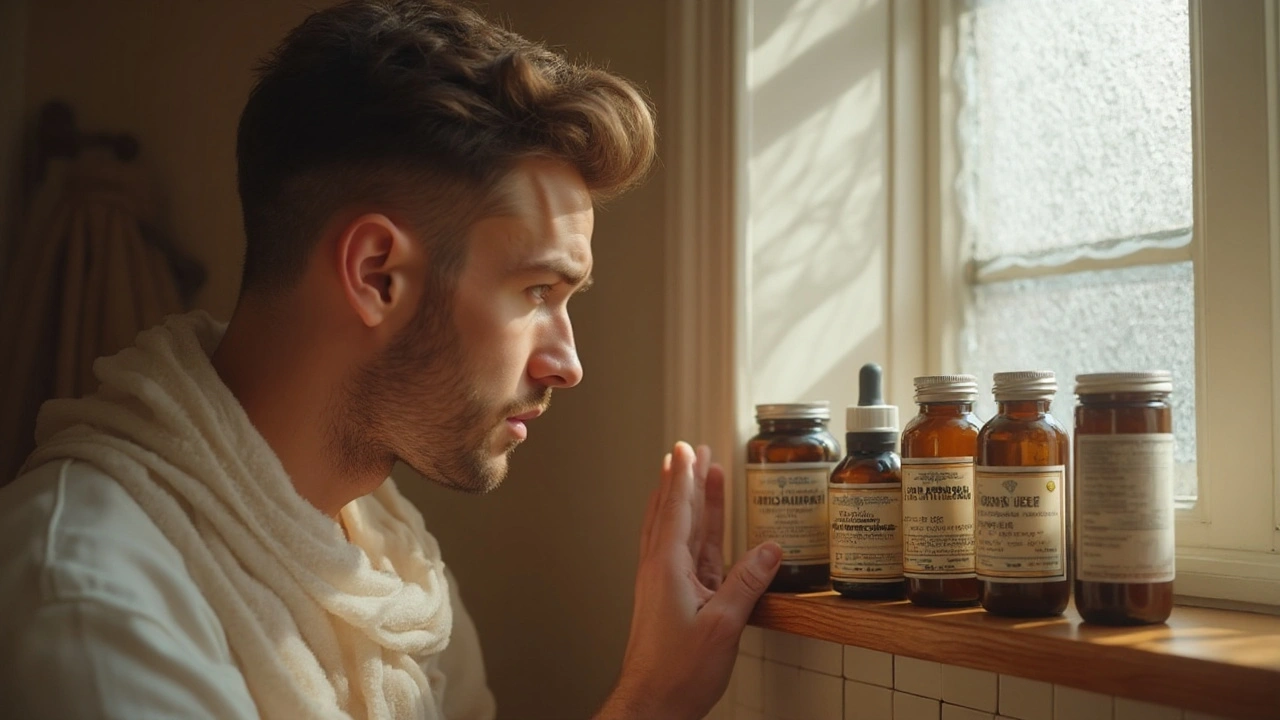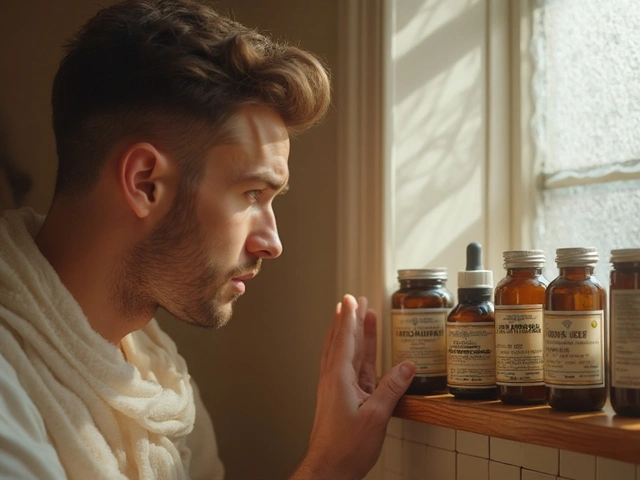Finasteride Alternatives: Low-Dose Dutasteride, Topical Options, and Nutraceuticals Explained

What if patchy facial hair or hair thinning could be solved without the trade-off of unwanted side effects? If you’ve searched for hair loss treatments, you’ve likely tripped over the classic finasteride-versus-everything else debate. But the real story is way more interesting and complicated than most blogs will let you believe. From men nervous about sexual side effects, to women worried about safety, loads of people want a finasteride alternative without side effects and aren’t sure what, if anything, actually fits the bill.
Why People Seek Finasteride Alternatives
Finasteride’s been a mainstay for male pattern baldness and prostate health for ages. It works by blocking an enzyme called 5-alpha reductase, which cuts down testosterone turning into DHT—the hormone that shrinks hair follicles. But here’s the catch: some folks on finasteride report decreased libido, erectile issues, breast sensitivity, and feeling down in the dumps. Statistically, those side effects aren't super common—about 2-4% report them during studies—but when it hits, that’s no comfort.
Diving into internet forums and support groups, you’ll find stories ranging from run-of-the-mill mild side effects to what’s been called post-finasteride syndrome. Even big names in medicine, like the NHS and Mayo Clinic, have lists of possible side effects that can make anyone pause. That’s why alternatives are such a hot topic right now. Men in their 20s consider the risks, especially if starting finasteride young. Women, for whom finasteride is off-limits due to risk in pregnancy, are stuck with even fewer choices.
It’s not just sexual side effects, either. Some report issues like brain fog and fatigue, though those are less well-documented. No wonder hair loss clinics in the UK, US, and beyond now field weekly questions about off-label, adjusted-dose, or plant-based alternatives. The idea of a "side effect-free" solution is appealing—but does it exist?
Low-Dose Dutasteride: Is Less Really More?
If you take a peek at recent research, low-dose dutasteride keeps popping up. Dutasteride works a lot like finasteride but it blocks more types of the 5-alpha reductase enzyme (Type I and II instead of just II). That means it's typically even more potent against DHT. The standard dose for prostate issues is 0.5mg daily, but for hair loss, some specialists use doses as tiny as 0.1mg or even just a couple times per week.
So does lowering the dose cut the risk? In a real-world Korean study from 2022, men who switched from 0.5mg daily to 0.1mg every other day kept most of their regrowth—and side effect complaints dropped by more than half. These "micro dosing" regimens have become popular in some hair loss clinics, hoping to balance benefit with reduced risk.
But, of course, there’s no magic math. You’ll still find some folks who get side effects even at those tiny doses, and it’s impossible to predict who’ll be sensitive. One tip: chat to your GP before switching, and if you do, track your side effects and results in a simple phone note or calendar. More importantly, dutasteride isn’t approved for hair loss everywhere—so finding a legit online pharmacy, or clinics that do supervised compounding, is tricky in many countries. If you’re going abroad, especially Turkey or Thailand, clinics often quietly use low-dose dutasteride in their own blends. There’s risk in buying it on the sly, as fake meds are a real problem according to a 2024 WHO alert.
| Treatment | Usual Dose for Hair Loss | Reported Side Effects (%) | Has UK/EU Approval? |
|---|---|---|---|
| Finasteride | 1mg daily | 2-4% | Yes |
| Dutasteride | 0.5mg weekly–0.5mg daily | 2-8% | No* |
| Topical Finasteride | 0.25-0.5% once daily | ~1% | No* |
| Nutraceuticals | Varies | Rare | Yes (supplements) |
*Not licensed specifically for hair loss in UK/EU but sometimes prescribed off-label.

Topical Finasteride: Smarter Delivery, Fewer Issues?
If you hate the idea of popping a tablet, topical finasteride might sound good. This newer approach takes that enzyme-blocking power and puts it right onto your scalp, so supposedly less makes its way into your bloodstream. Early studies (look up Caserini et al., 2021, if you’re nerdy like me) show that men using a 0.25% topical finasteride solution daily had about half the rate of sexual side effects compared to those taking it by tablet, without a huge difference in hair regrowth at 24 weeks.
Now here’s where it gets interesting: the UK’s MHRA and EU’s EMA haven’t officially given them a green light yet. That means getting these drops often means heading to a compounding pharmacy with a helpful doctor’s script or shopping online with a careful eye (hello, sketchy imitation medicines). Italy and Spain seem a little ahead—their doctors prescribe this off-label almost as much as oral finasteride for men nervous about side effects. In the UK, most GPs can’t write a prescription for it, but you’ll find private derm clinics starting to offer it in small numbers.
What about actual side effects? Application-site itch and mild redness show up in 5–10% of guys, and a handful get headaches. The big plus: rates of sexual or hormonal side effects land closer to 1%, sometimes even lower. It’s not zero. And it’s not a miracle, but if you’re looking for a finasteride alternative without side effects, this might be the closest pharmaceutical option so far.
Tips for anyone considering topical finasteride? Go slow! Some users try every-other-day application at first, then step up. Try not to rub it beyond your target area, and wash hands straight after—the goal is to treat your scalp, not absorb through your palms or end up in your eyes. If it’s compounded, check the shelf life, as some blends go off quickly at room temp, especially ones with minoxidil mixed in.
Nutraceuticals: Can Supplements Really Help?
Herbal pills and powders promising less hair on your brush are everywhere. But do they actually stack up next to medical options? The truth’s in the details. Saw palmetto, pumpkin seed oil, and marine collagen get the most hype, each nudged on social media by wellness influencers, often with glossy “before and after” shots that are tough to fact-check.
Saw palmetto’s the only one with a decent number of small, double-blind studies behind it. In 2021, a review out of Milan pooled results from 7 trials and found that 38% of users saw "significant reduced shedding" over six months. One side effect? A few men noted mild stomach upset. You rarely hear about sexual side effects with these supplements—but that doesn’t mean zero risk. In rare cases, men with extremely high doses of saw palmetto experienced mild erectile changes, though nothing like with finasteride. Pumpkin seed oil gets mentioned thanks to a quirky 2014 Korean study—researchers found men taking it daily for six months had 40% thicker hair by count. Collagen and biotin? Much less evidence, but low risk and pretty cheap for a DIY test run.
But no supplement can claim the same punch as prescription meds. These are more like “mild boosters” for folks at early stages, or those who can’t tolerate meds at all. Make them “plan B,” not your only line of defense. Always run the labels by your GP if you’re on other medications, as some herbals can mess with blood thinners or hormone treatments.
- B12 and iron: If you suspect a deficiency, correcting that can aid hair regrowth far more than any herb.
- Stay clear of megadoses: They won’t help, and could even backfire.
- Batch quality counts: Supplements aren’t tightly regulated—go for brands that publish test results, not just pretty Insta stories.

How to Choose Your Safe Hair Loss Path
This landscape can be overwhelming. You’ve got prescription pills, topical blends, gummies, and weird mushroom teas. Your starting point probably comes down to your own risk tolerance and expectations. If you’re after the highest regrowth rates and can live with watching for side effects, pharmacy-grade meds (like finasteride or low-dose dutasteride) still reign. If you’re on the fence, topical treatments might get you 80% of the benefit with noticeably less risk—especially if sex-drive or mental health shifts freak you out. For chronic worriers, or those super sensitive to medication, nutraceuticals are a gentle nudge rather than a strong fix.
Don’t forget the basics. Diet matters. Smoking and ongoing stress can both do a number on your hair roots, even before hormones like DHT join the party. Regular sleep, some scalp massage, and minimising harsh styling also make a difference. If you’re thinking about starting any of these options, give it at least 4-6 months before judging the results. That’s just how long the hair cycle takes—and changing brands or doses every few weeks will only confuse you (and your follicles).
For the proper sceptics among us: there’s still no 100% "side effect free" or instant solution in 2025. Social media might promise wild, overnight results from some rare berry from Peru, but science just isn’t there yet. Stick with what’s proven, take it slow, and don’t shy from a doctor’s advice if something feels off. For a deeper head-to-head breakdown of these choices and more on the topic of a finasteride alternative without side effects, you’ll find lots of practical details from real users and experts at the linked post.
Hair loss is personal, emotional, and sometimes frustrating, but with more choices than ever, there’s no need to settle for all-or-nothing thinking. Take the science, try what fits, and don’t be afraid to adjust along the way. Your hair, your rules.


Sue Berrymore
Topical finasteride seems like the pragmatic middle ground for most people who want solid results without committing to systemic pills.
Putting the active drug where the hair lives reduces systemic exposure and frankly that trade-off matters more than people admit. Low-dose dutasteride is tempting for its potency, but it carries a bigger systemic footprint even when microdosed. If someone wants to avoid blood‑level effects, topical finasteride plus minoxidil in a stable formulation is usually the cleaner route. Track photos and notes every month, and don't blame the treatment if you switch protocols too often. Also, invest in a decent compounding source if you go topical, because cheap mixes ruin outcomes more than they help.
Roberta Saettone
Topical finasteride is probably the single best middle ground for most people looking to cut systemic risk while keeping decent results.
Putting the drug where the problem is makes pharmacologic sense, and the early data shows plasma exposure is much lower than with oral dosing. That lower systemic exposure should translate to fewer systemic hormonal effects, and the small trials reflect that trend. But lower exposure does not mean zero exposure, and a cautious mindset is required when starting. Clinical practice has shown that some patients still report sexual side effects or mood shifts even with topicals, though at a much lower rate. Compounding quality is a huge variable that patients rarely think about until something goes wrong. Standardized manufacturing reduces variability and contamination risk, whereas small compounding shops sometimes mix solvents or preservatives that irritate the scalp. Combining topical finasteride with minoxidil can be effective, but that mix should ideally be stabilized in a proper formulation to avoid degradation. Patients using home-mixed blends often get inconsistent results and wasted money. If you go the route of low-dose dutasteride, expect stronger DHT suppression because it hits both 5-alpha reductase isoenzymes. Microdosing seems promising but is still mostly based on observational registries and small cohorts rather than large randomized trials. Track symptoms and objective photos consistently, and give any regimen six months before drawing conclusions. Supplements like saw palmetto can be useful as adjuncts for people who refuse pharmaceuticals, but the effect size is modest and variable. Nutritional status is often overlooked; correcting iron, vitamin D, or B12 deficiencies will out-perform many supplements in hair outcomes. Finally, coordinate with a clinician who will follow your labs and side effects rather than relying on internet anecdotes and unverified pharmacies. Being proactive with monitoring and realistic expectations is the most practical way to avoid regret down the line.
Stephen Nelson
Low-dose everything is the comforting myth du jour, wrapped in the illusion of control.
Dutasteride microdosing reads like wishful arithmetic where potency is magically tamed by lower milligrams. Real life throws in individual metabolism and receptor sensitivity that laugh at that neat math. If you want dramatic results, the stronger the suppression the greater the chance of collateral effects. If you want zero collateral, prepare to accept much smaller gains. That is the trade-off in a single neat sentence that people scroll past.
Fredric Chia
Correct assessment. Efficacy and systemic exposure correlate; one cannot be maximized without affecting the other to some degree.
Julia Odom
Topicals and nutraceuticals deserve measured praise rather than blind worship.
Saw palmetto has data but it remains modest, and supplements suffer from batch variability and marketing pomposity. Relying on a nutrient check first is sensible; correcting iron or B12 deficiency is a pragmatic move that many overlook while chasing pharmacologic silver bullets. The compounding sphere needs stricter quality filters, and patients should favor clinics that publish stability data for their mixes. If someone opts for microdosed dutasteride, they should do so with documented baselines and ongoing symptom logs. Ultimately, realistic expectations and disciplined follow-up separate useful interventions from expensive placebo hunts.
Hope Reader
Totally agree with the nutrient-first approach and careful follow-up :)
Supplements are fine as backup but not as the main strategy, and a clear log of changes helps separate real effects from wishful thinking.
Marry coral
Supplements only work if you actually need them, plain and simple.
People dump cash into every trendy pill and then wonder why nothing changes. Fix deficiencies, stop stressing, sleep properly, then pick one targeted treatment and stick with it. Flipping between products every month just trains you to be disappointed. If you want results, consistency beats novelty every time.
Emer Kirk
this is everything
you waste money you feel stupid you panic
then you try the next thing
and nothing changes
Ian Parkin
Topical first, supplements second.
Karen Wolsey
Low-dose dutasteride getting traction makes total sense to me because people want balance not extremes.
Microdosing to keep gains while cutting side effects is exactly the kind of pragmatic approach a lot of us need, especially when starting in your 20s and wanting to avoid messing with libido or mood. The trick is tracking results and side effects properly, so you actually know whether the tweak helped or not. I keep a simple weekly note on my phone listing shedding, libido, sleep, and mood and it really clarifies whether a change mattered.
If anyone’s trying topical finasteride, be careful about rub-off and hand hygiene - it’s easy to apply outside the target area and get unintended exposure. Also, if a clinic is offering compounds with weird ingredients or guaranteed overnight miracles, walk away.
Trinity 13
Low-dose dutasteride is interesting not because it's a miracle but because it reframes risk management in a field that usually pushes all-or-nothing solutions. For ages patients were told to take full-dose meds or do nothing, and that binary logic ignores how people actually live with trade-offs. Those studies showing lower side effect reports at lower dosing aren't fairy tales, they just force clinicians and patients to negotiate a new middle ground where benefit and tolerability are both respected.
In practice this means several things. First, baseline data is essential: know your libido baseline, baseline mood, and any cardiovascular or metabolic conditions before starting anything that touches hormones. Second, start conservatively and titrate. If you begin with a 0.1mg schedule or an every-other-day approach, give it time because a messy four-week period doesn't mean the regimen failed - hair cycles are slow and hormones can take time to adapt. Third, be meticulous about sourcing; fake meds are common and a WHO alert in 2024 made that plain. Compounding pharmacies can be fine but insist on batch testing and a clear supply chain. Fourth, topical options deserve real attention because they alter pharmacokinetics: less systemic exposure means lower risk for systemic side effects while still delivering DHT suppression where it matters. That said, topical applications have their own quirks - local irritation, variable absorption based on skin condition, and stability problems in certain combined formulas like minoxidil plus finasteride. Fifth, nutraceuticals are useful as adjuncts for people at early stages or who are hypersensitive to pharmaceuticals: saw palmetto has the best small-study backing, pumpkin seed oil has odd but reproducible signals in some trials, and collagen/biotin are basically low-risk maintenance moves. Sixth, whatever you pick, commit for at least 4–6 months unless something severe happens, because the hair cycle will mislead you otherwise.
Clinically, I think the future is personalized combos: low systemic dose, topical application, and targeted supplements plus lifestyle fixes like iron optimization and stress reduction. The actual art is in measuring and adjusting, not heroically chasing the one correct drug. This is where clinics that offer supervised microdosing and proper follow-up are adding real value - they treat it like chronic care rather than a quick fix. And lastly, if someone is really fearful of sexual side effects or mood change, begin with non-systemic options and nutritional corrections, and only escalate to systemic agents if the situation warrants it. That conservative choreography preserves options later on, which is crucial because stopping and restarting systemic meds can be frustrating for regrowth continuity.
Rhiane Heslop
Topical finasteride is the practical compromise a lot of guys need. It gives good scalp exposure with way less systemic spillover. The data so far lines up with what clinics are seeing - fewer sexual side effects and decent regrowth for many users.
Real talk: no treatment is zero-risk. If you’re risk averse, start with topicals and quality supplements, follow bloodwork when possible, and stay off the sketchy marketplaces.
Dorothy Ng
Dutasteride blocking both type I and II 5-alpha reductase enzymes explains why it's more potent than finasteride, and that potency is a double-edged sword. More DHT suppression often equals better hair outcomes but also a higher chance of systemic effects when absorption occurs. That is biologically straightforward and worth bearing in mind when someone suggests "just lower the dose and all is solved."
Also, nutraceuticals are not neutral: they interact with medications and can affect liver enzymes, so run any supplement list by a clinician if you're on meds. Batch testing and third-party verification are not optional if you care about safety.
Justin Elms
Good point about measurement and gradual change - start small and track.
From a practical standpoint, keep simple logs: sleep, mood, libido, shaving frequency, and a weekly selfie. That's actionable data and beats vague memory. If you go topical, patch test first for irritation and wash hands right after application to avoid transfer. And if you try supplements, pick one at a time for a few months so you can attribute any improvements correctly.
Jesse Stubbs
Low-dose dutasteride or nowhere, honestly.
Melissa H.
Totally get the attraction, it worked well for a friend and the side effects dropped off after a couple weeks 🙂
People should still keep notes though and opt for labs if anything odd pops up, because anecdote only goes so far.
Edmond Abdou
Checklist that helped a dozen mentees over the last two years: source verification, starting dose plan, baseline labs, weekly self-assessment, monthly photos, and a stop/scale-back trigger. If any single step is skipped, interpretation becomes guesswork.
One more thing: travel and dosing schedules matter. If someone is trying microdosing while flying or on different timezones, adherence slips and then people convince themselves the regimen failed when it was a timing issue.
Sydnie Baker
The discourse around finasteride alternatives often reads like a carnival of half-informed panaceas, a veritable symposium of hope masquerading as evidence. For those who prize epistemic humility, the sensible posture is to triangulate: weigh randomized data, mechanistic plausibility, and pragmatic clinic experience rather than surrendering to marketing hyperbole. Dutasteride’s broader enzymatic blockade confers greater efficacy, indisputably, but it also amplifies the plausible vectors for systemic perturbation, which is the trade-off that deserves measured consideration.
Topical formulations are not metaphysical cures but a pharmacokinetic refinement, an elegant attempt to localize action while minimizing systemic burden. That approach is intellectually satisfying and, in many cases, clinically useful. Nutraceuticals occupy a different ontology: they are adjunctive at best, placebo-prone at worst, yet low-risk for many and thereby a defensible early strategy for mild presentations. The prudent practitioner will deploy them with caveats, not as replacements for mechanistically targeted therapy.
In short, adopt a stratified framework: lifestyle and deficiency correction first, topical or microdosed pharmacotherapy second, and full systemic dosing reserved for those with substantial alopecia or refractory progression. This layered approach honors both efficacy and safety in equal measure.
Benjie Gillam
Interesting point about travel and adherence - temporal consistency matters more than most people admit. A half-life mismatch or missed dose every third day can produce noisy outcomes that people then misinterpret as treatment failure.
Pharmacologically, microdosing creates a new steady-state dynamic that is non-linear in effect; small changes in timing can shift serum levels disproportionately compared to larger daily dosing. Clinically that implies you should be as ritualistic about dosing schedules for microdoses as you are with stronger daily meds, because the margin for error is smaller.
Karen Wolsey
I like the checklist idea and the emphasis on measuring outcomes.
One quick practical tip from personal experience: use one consistent light and angle for your monthly photos. Natural light in the morning works best for me and makes comparisons far less flaky. Also keep a short notes column about stressors like travel or sleep loss so you can correlate those with shedding spikes.
Trinity 13
Agree with the ritualization advice - consistency is underrated.
When people fail to see results they often change multiple variables at once: new shampoo, a supplement, a dosing tweak, and suddenly they can't attribute outcomes to anything. The simplest move to better insight is single-variable changes with set windows: pick one tweak, commit for three months, then reassess. Repeat as needed. That discipline separates noise from signal in a messy biological system.
Also, consider basic endocrine screening once a year if you’re on systemic agents - it’s cheap relative to long-term uncertainty and gives both patient and clinician real data to discuss. And if someone is on antidepressants or antihypertensives, declare those upfront to your hair clinician because interactions and overlapping side effect profiles change risk calculus. This field needs fewer hucksters and more methodical care paths.
Dorothy Ng
Short add-on: iron and B12 deficiency can mimic or worsen hair thinning, so simple blood tests can be the highest-yield move before long-term drug decisions. Correcting deficiencies sometimes produces clearer results than chasing the latest supplement fad.
Justin Elms
Wrapping this up: start with basics, track carefully, choose a path that fits your risk tolerance, and get lab backup if you go systemic.
Patience pays off and small disciplined steps beat impulsive binges on internet hype.